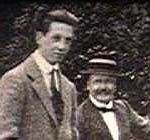|
|
|
|

NASA's
Fermi Gamma-ray Space Telescope picked up the gamma
ray flash that came with the first detected gravitational
waves.
|
Science
Over the Edge
A
Roundup of Strange Science for the Month
March
2016
|
|
In the
News:
 Detected
Gravitational Waves Result of Black Hole Collision - The
first gravitational waves detected back on Sept. 14, 2015,
may have been the result of two black holes colliding within
a supermassive star. "It's the cosmic equivalent of a pregnant
woman carrying twins," said astrophysicist Avi Loeb, with
the Harvard-Smithsonian Center for Astrophysics. Black holes
form when massive stars explode. In this case scientists
think that the star was spinning so fast that the center
formed into a dumbbell shape with each end becoming one
of the holes. The holes then quickly merged causing the
wave and then later fueling a burst of gamma rays. The rays
were detected by NASA's Fermi Gamma-ray Space Telescope
just 0.4 seconds after the Laser Interferometer Gravitational-wave
Observatory (LIGO) picked up the gravitational waves. "In
order to power both the gravitational wave event and the
gamma-ray burst, the twin black holes must have been born
close together, with an initial separation of order the
size of the Earth, and merged within minutes. The newly
formed single black hole then fed on the in-falling matter,
consuming up to a sun's worth of material every second and
powering jets of matter that blasted outward to create the
burst," stated the Harvard-Smithsonian Center for Astrophysics. Detected
Gravitational Waves Result of Black Hole Collision - The
first gravitational waves detected back on Sept. 14, 2015,
may have been the result of two black holes colliding within
a supermassive star. "It's the cosmic equivalent of a pregnant
woman carrying twins," said astrophysicist Avi Loeb, with
the Harvard-Smithsonian Center for Astrophysics. Black holes
form when massive stars explode. In this case scientists
think that the star was spinning so fast that the center
formed into a dumbbell shape with each end becoming one
of the holes. The holes then quickly merged causing the
wave and then later fueling a burst of gamma rays. The rays
were detected by NASA's Fermi Gamma-ray Space Telescope
just 0.4 seconds after the Laser Interferometer Gravitational-wave
Observatory (LIGO) picked up the gravitational waves. "In
order to power both the gravitational wave event and the
gamma-ray burst, the twin black holes must have been born
close together, with an initial separation of order the
size of the Earth, and merged within minutes. The newly
formed single black hole then fed on the in-falling matter,
consuming up to a sun's worth of material every second and
powering jets of matter that blasted outward to create the
burst," stated the Harvard-Smithsonian Center for Astrophysics.
 Queen
of Egypt Tomb Explored - Archeologists have been examining
the tomb of Khentkaus III, queen of Egypt 4,500 years and
hope to find more information out about that era in which
she lived as little is known. Her remains were first found
in November in a necropolis in Abusir, near Cairo, were
she was emtombed a few hundred feet away from her husband,
Pharaoh Neferefre. The identity of his principal wife was
still unknown till this find. Scientists hope that the contents
of the tomb will better help them understand the Old Kingdom
period (2649--2150 BC) in which she lived. It was a time
in which there was turmoil in Egypt as politics changed.
It's "a crucial period when the Old Kingdom started to face
major critical factors: The rise of democracy, the horrific
impact of nepotism and the role played by interest groups,"
noted project leader Professor Miroslav Barta of the Czech
Institute of Egyptology. Queen
of Egypt Tomb Explored - Archeologists have been examining
the tomb of Khentkaus III, queen of Egypt 4,500 years and
hope to find more information out about that era in which
she lived as little is known. Her remains were first found
in November in a necropolis in Abusir, near Cairo, were
she was emtombed a few hundred feet away from her husband,
Pharaoh Neferefre. The identity of his principal wife was
still unknown till this find. Scientists hope that the contents
of the tomb will better help them understand the Old Kingdom
period (2649--2150 BC) in which she lived. It was a time
in which there was turmoil in Egypt as politics changed.
It's "a crucial period when the Old Kingdom started to face
major critical factors: The rise of democracy, the horrific
impact of nepotism and the role played by interest groups,"
noted project leader Professor Miroslav Barta of the Czech
Institute of Egyptology.
 Why
Did Mary Ingalls Go Blind? - If you ever read or watched
"The Little House on the Prairie" you probably know that
Mary Ingalls went blind from scarlet fever, right? Well,
the truth may be a bit more complicated. The author, Laura
Ingalls Wilder, based the stories on her early life and
on her sister who really did go blind. As a medical student
Dr. Beth Tarini was intrigued when she found out that scarlet
fever only produced temporary blindness and decided to do
some more research on Mary's disease. Using medical records,
letters and newspaper accounts Tarini found that it appears
Mary Ingalls actually suffered from meningoencephalitis,
a disease that inflames the brain and associated areas.
In some cases it can also affect the optic nerve causing
people to go slowly blind. Tarini thinks that Wilder decided
that Mary's actually diagnosis was too complicated for literary
purposes and substituted scarlet fever, which was a greatly
feared disease at the time, though it is easily treatable
today. Why
Did Mary Ingalls Go Blind? - If you ever read or watched
"The Little House on the Prairie" you probably know that
Mary Ingalls went blind from scarlet fever, right? Well,
the truth may be a bit more complicated. The author, Laura
Ingalls Wilder, based the stories on her early life and
on her sister who really did go blind. As a medical student
Dr. Beth Tarini was intrigued when she found out that scarlet
fever only produced temporary blindness and decided to do
some more research on Mary's disease. Using medical records,
letters and newspaper accounts Tarini found that it appears
Mary Ingalls actually suffered from meningoencephalitis,
a disease that inflames the brain and associated areas.
In some cases it can also affect the optic nerve causing
people to go slowly blind. Tarini thinks that Wilder decided
that Mary's actually diagnosis was too complicated for literary
purposes and substituted scarlet fever, which was a greatly
feared disease at the time, though it is easily treatable
today.
 Ocean
Level Rising Fast - A study published in Proceedings
of the National Academy of Sciences says that oceans are
rising at a faster than any time in the past 2,800 years.
According to the paper sea levels climbed by about 5.5 inches
in the century ending in the year 2000. "The 20th century
rise was extraordinary in the context of the last three
millennia - and the rise over the last two decades has been
even faster," said lead author Robert Kopp, from Rutgers
University's Department of Earth and Planetary Sciences.
The report suggests that even if fossil fuels were phased
out immediately, ocean levels would still climb between
eight tenths of a foot and two feet by the end of the century. Ocean
Level Rising Fast - A study published in Proceedings
of the National Academy of Sciences says that oceans are
rising at a faster than any time in the past 2,800 years.
According to the paper sea levels climbed by about 5.5 inches
in the century ending in the year 2000. "The 20th century
rise was extraordinary in the context of the last three
millennia - and the rise over the last two decades has been
even faster," said lead author Robert Kopp, from Rutgers
University's Department of Earth and Planetary Sciences.
The report suggests that even if fossil fuels were phased
out immediately, ocean levels would still climb between
eight tenths of a foot and two feet by the end of the century.
|
|
 Science
Quote of the Month - "Progress
is made by trial and failure; the failures are generally
a hundred times more numerous than the successes ; yet they
are usually left unchronicled." - William
Ramsay. Science
Quote of the Month - "Progress
is made by trial and failure; the failures are generally
a hundred times more numerous than the successes ; yet they
are usually left unchronicled." - William
Ramsay.
|
|
What's
New at the Museum:
 The
Sewers of London: There were many great works of spectacular
engineering in the 19th century such as gigantic steamships,
innovative bridges and fantastic buildings. None of them,
however, saved as many lives as this immense and complex
infrastructure project under the streets of one of the largest
cities of the world. > Full
Story The
Sewers of London: There were many great works of spectacular
engineering in the 19th century such as gigantic steamships,
innovative bridges and fantastic buildings. None of them,
however, saved as many lives as this immense and complex
infrastructure project under the streets of one of the largest
cities of the world. > Full
Story
 Mysterious
Picture of the Month - What
is this this? Mysterious
Picture of the Month - What
is this this?

|
|
Ask
the Curator:
 I'm
trying to figure out where to buy Quartz Rock, can you help
me? I would definitely appreciate it. -
Sincerely, Brandon I'm
trying to figure out where to buy Quartz Rock, can you help
me? I would definitely appreciate it. -
Sincerely, Brandon
Finding
someone to sell you quartz will be a lot easier than picking
from the many variations of quartz there are including Amethyst,
Rose Quartz and Smoky Quartz. If you want to shop on-line
you may want to try a site like www.johnbetts-fineminerals.com
which has a nice gallery of all kinds of rocks that you
can view and buy. Quartz specimens are available there starting
at about $15. If you want to go cheaper and see the goods
in person before you buy you should try a local rock shop.
They should be listed in your yellow pages. Finally, you
might want to consider joining a local geology club. The
site www.gemandmineral.com/states.html
keeps a list of geology clubs and rock related organizations
throughout the U.S.
Have
a question? Click here to
send it to us.
|
| In
History:
 Bone
Wars Battle - March of 1872 marks a skirmish in the
"Bone Wars" between 19th century scientists Edward Cope
and Othniel C. Marsh. On March 12 Cope published an article
about two new fossils from Kansas of two large winged reptiles,
of the family of Ornithosaurians. Unfortunately his
rival Marsh described the same animals in an article that
came out on March 7th. American Journal of Science
gave the naming rights to Marsh because his article had
come out a few day earlier, even though Cope had read his
paper to the American Philosophical Society on March
1st. Cope fought the decision until 1875, but eventually
recognized that Marsh had been awarded the find. Bone
Wars Battle - March of 1872 marks a skirmish in the
"Bone Wars" between 19th century scientists Edward Cope
and Othniel C. Marsh. On March 12 Cope published an article
about two new fossils from Kansas of two large winged reptiles,
of the family of Ornithosaurians. Unfortunately his
rival Marsh described the same animals in an article that
came out on March 7th. American Journal of Science
gave the naming rights to Marsh because his article had
come out a few day earlier, even though Cope had read his
paper to the American Philosophical Society on March
1st. Cope fought the decision until 1875, but eventually
recognized that Marsh had been awarded the find.
|
|
In
the Sky:
 Penumbral
Lunar Eclipse - Depending on where you are on March
23rd you might be able to catch the Penumbral Lunar Eclipse.
This occurs when the Earth gets between the sun and the
moon, but its shadow does not fully cover the lunar surface.
This results in the moon turning a dark, reddish color.
If the sky is clear the eclipse should be visible from eastern
Asia, eastern Australia, the Pacific Ocean, and the west
coast of North America including Alaska. Penumbral
Lunar Eclipse - Depending on where you are on March
23rd you might be able to catch the Penumbral Lunar Eclipse.
This occurs when the Earth gets between the sun and the
moon, but its shadow does not fully cover the lunar surface.
This results in the moon turning a dark, reddish color.
If the sky is clear the eclipse should be visible from eastern
Asia, eastern Australia, the Pacific Ocean, and the west
coast of North America including Alaska.
|
|
Observed:
 Boy Finds Ancient Artifact - A 7-year-old Israeli boy
found a 3,400 year-old figurine on a day trip to an archeological
site. Ori Greenhut was climbing a mound at Tel Rehov when
he noticed the clay likeness of a woman in the dirt. Brushing
it off, the boy took it home as a souvenir. On seeing it
his mother contacted authorizes which identified it as being
typical of the Canaanite culture. Amihai Mazar, a professor
and expedition director of the excavations at Tel Rehov
believes it may be a depiction of a real woman or the fertility
goddess Astarte made by pressing soft clay into a mold.
The object has been turned over to Antiquities Authority.
Boy Finds Ancient Artifact - A 7-year-old Israeli boy
found a 3,400 year-old figurine on a day trip to an archeological
site. Ori Greenhut was climbing a mound at Tel Rehov when
he noticed the clay likeness of a woman in the dirt. Brushing
it off, the boy took it home as a souvenir. On seeing it
his mother contacted authorizes which identified it as being
typical of the Canaanite culture. Amihai Mazar, a professor
and expedition director of the excavations at Tel Rehov
believes it may be a depiction of a real woman or the fertility
goddess Astarte made by pressing soft clay into a mold.
The object has been turned over to Antiquities Authority.
|
|
LGM:

Zeep
and Meep are on a well deserved vacation. In their place
we feature highlights from their past adventures.
LGM
Archive 1998, 1999, 2000, 2001, 2002, 2003, 2004, 2005, 2006, 2007,
2008, 2009,
2010, 2011,
2012,
2013,
2014

Copyright Lee Krystek 2015. All Rights Reserved.
|
|
|
|





